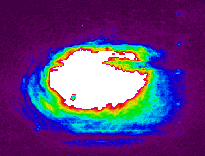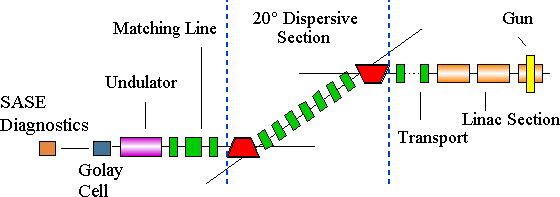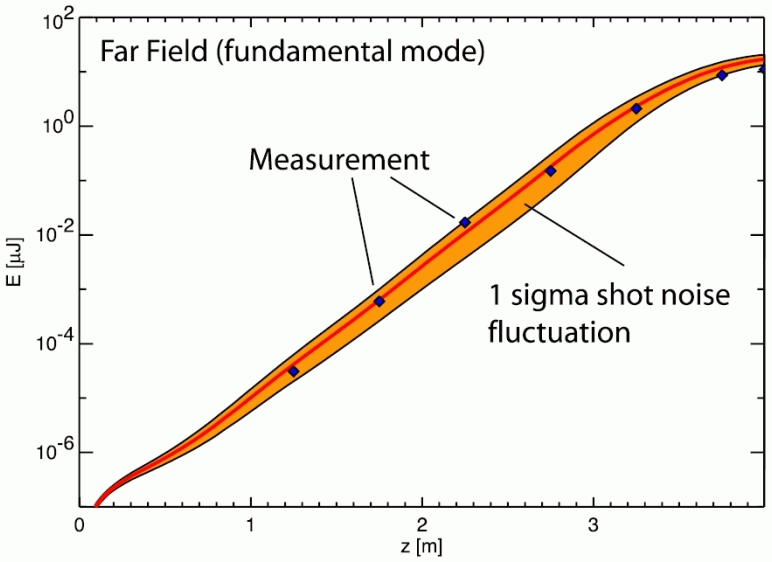
by M. Cornacchia (SSRL), H.-D. Nuhn (SSRL) and C. Pellegrini (UCLA) for the VISA collaboration
 |
|
| Figure 1 Intensity distribution of a Single SASE radiation pulse as produced by VISA when operating at saturation. |
In a SASE FEL, lasing is achieved when a high-brightness electron beam interacts with an intense beam of light while traveling through the periodic magnetic field of an undulator. Under the right conditions, a collective instability develops, and the electrons in the bunch, which are initially randomly distributed, acquire a longitudinal density modulation at the optical wavelength leading to coherent emission and to a large enhancement of radiation power. The net result is an exponential increase of radiated power. This increase will eventually saturate at power levels about seven orders of magnitude above conventional undulator radiation. The radiation pulses produced by the SASE FEL are of sub-picosecond duration and fully transversely coherent.
The development of SASE FELs at SLAC started ten years ago with the study of the Linac Coherent Light Source (LCLS) [1], following the development of the SASE theory in the preceding decade. The experimental demonstration of the SASE-FEL collective instability and the agreement between the experimental data and the theory was achieved in the late 90s, initially in an experiment at UCLA, followed by other experiments at Los Alamos and Brookhaven by a UCLA-SLAC-LANL-BNL collaboration. More recently, other experiments have been done at Argonne and DESY, extending the SASE-FEL operation to the UV region. Today, in addition to the LCLS project at SLAC, another x-ray SASE FEL facility is being developed at the DESY laboratory in Germany and a number of longer wavelength devices are being proposed at other locations worldwide.
Three long wavelength experiments have been carried out, recently, to verify that the ultra-high density electron beams needed for the LCLS can be generated, transported and manipulated, to further study the SASE FEL physics, and to verify that the SASE process does saturate at the predicted distance from the beginning of the undulator. One of them, the Visible to Infrared SASE Amplifier (VISA) experiment, a SLAC-BNL-LLNL-UCLA collaboration [2], was carried out in 2001 with major participation from SSRL.
Saturation occurs in a SASE FEL when
the maximum gain possible, for a given parameter set, has been achieved.
At saturation, shot-to-shot intensity fluctuations are reduced. The LCLS
is being designed to operate in the saturation regime. The distance from
the beginning of the undulator to the point at which saturation occurs
as well as the per-pulse radiation energy at saturation have been predicted
theoretically but had not been measured in an experiment until recently.
The VISA experiment, conducted at
the Accelerator Test Facility (ATF) (Figure 2) of the Brookhaven
National Laboratory (BNL) in New York, has studied the properties of the
SASE FEL process in a saturating system. First evidence of saturation was
observed on March 16, 2001. The experiment utilized a high brightness electron
injector and a strong focusing 4-m long undulator. The design parameters
are listed in Table 1. A saturated gain greater than 108,
with an e-folding power gain length smaller than 19 cm, was observed at a
radiation wavelength of 840 nm. Measurements of exponential gain, and of the
intensity and the spectral and angular properties of the radiation have been
carried out, and the results have been compared to theory and to start-to-end
simulations of the injector, the beam transport, and the undulator system
(Figure 3). High gain conditions were found to be
critically dependent on compression of the electron beam during transport.
Table 1 VISA FEL Design Parameters
| Wavelength (fundamental) | 800 nm |
| E-Beam Energy | 72 MeV |
| Peak Current | 200 A |
| Normalized Emittance | 2 mm – mrad |
| Energy Spread | 0.17 % |
| Power Gain Length | 18.5 cm |
| Spot Size | 60 mm |
 |
| Figure 2 The components of the VISA experiments. The electron bunches are generated in the photocathode RF Gun, on the right-hand-side, and travel to the left towards the Undulator. Bunch length compression occurs in the Dispersive Section. The SASE radiation is generated in the Undulator and diagnosed by Golay cell’s, bolometers and CCD cameras following the undulator. |
The onset of FEL saturation after
7 orders of magnitude of gain was seen in the VISA experiment at about
3.6 m after the beginning of the undulator. The e-folding radiation power
gain length, supported by 5 data points taken at 50-cm separation along
the 4-m long undulator, was measured to be 18.5 cm. The wavelength of the
radiation was 840 nm, i.e. in the Near Infrared spectral region. This is
the second experiment that has shown SASE saturation. Saturation of a SASE
FEL was first observed in September 2000 in Argonne at the Low Energy Undulator
Test Line (LEUTL) FEL. Recently on September 10, 2001, the SASE FEL at
the TESLA Test Facility (TTF) at the DESY laboratory in Hamburg, Germany,
observed saturation at 98 nm wavelength.
 |
| Figure 3 The figure shows radiation pulse intensity in micro-Joule as a function of the distance from the entrance of the 4-m long undulator. The total intensity of the SASE radiation has been measured (blue dots) at eight ports spaced by 0.25 m along the undulator and at the undulator exit. At port 3, at 1.25 m from the Undulator entrance, SASE intensity starts to be distinguishable from spontaneous radiation. The solid lines are the result of start-to-end simulations using the computer codes PARMELA [3], ELEGANT [4], and GENESIS 1.3 [5]. The thinner, central line is the result of a typical run, while the upper and lower lines mark the rms distribution of the shot-to-shot intensity fluctuations of the SASE process. The measurements clearly show that saturation is occurring towards the end of the undulator as predicted by simulations. |
The factor that makes the VISA experiment
particularly significant is that its system requirements are very demanding
and similar to those of the LCLS project, which is designed to operate
in the spectral range of 0.15 to 1.5 nm. For example, VISA requires strong
quadrupole focusing, state-of-the-art alignment of the undulator segments,
and high quality of the undulator magnetic field; characteristics all shared
with the LCLS design.
One of the properties of
a SASE FEL is the generation of nonlinear harmonics, which occurs only
in the high gain and saturation regime. Both, simulation and theory predict
the intensity of the 3rd harmonic to be about 1% of the fundamental
for an x-ray SASE FEL. This is about 8 orders of magnitude brighter than
current third generation synchrotron radiation sources. The radiation is
transversely coherent and provides the possibility for SASE FELs to have
broad spectral coverage, i.e., it will make sub-Angstrom radiation available
from
the LCLS. The spectrum of SASE radiation has been measured for the
first time at the VISA experiment (see Figure 4). It confirms experimentally
that high quality nonlinear harmonic spectra can be expected for future
short wavelength SASE FELs driven by high-brightness electron beams.
 |
The VISA team will continue the work
through this year with a detailed study of the dependence of radiation
parameters on electron beam quality.
References:
- “Linac Coherent Light Source (LCLS) Conceptual Design Report,” SLAC-R-593, UC-414 (April 2002). http://ssrl.slac.stanford.edu/lcls/CDR/
- A. Tremaine, X. J. Wang, M. Babzien, I. Ben-Zvi, M. Cornacchia, H.-D. Nuhn, R. Malone, A. Murokh, C. Pellegrini, S. Reiche, J. Rosenzweig, and V. Yakimenko,“Experimental Characterization of Nonlinear Harmonic Radiation from a Visible Self-Amplified Spontaneous Emission Free-Electron Laser at Saturation.,” Phys. Rev. Lett. 88, 204801 (2002)
- L. M. Young, J. H. Billen, “Parmela”, LA-UR-96-1835, Rev, January 8, 2000.
- M. Borland, “Elegant: A Flexible SDDS-Compliant Code for Accelerator Simulation”, ICAP-2000, Darmstadt, Germany, September 2000.
- S. Reiche, Nucl. Instr. Meth. A429, 243 (1999).
SSRL Highlights Archive
